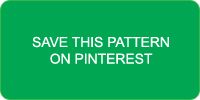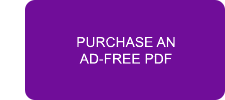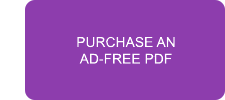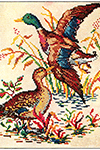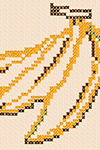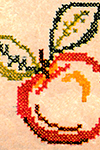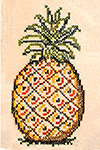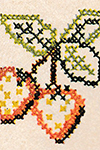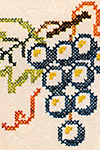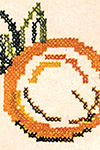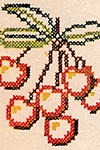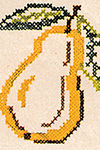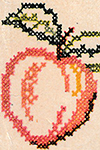Collie Chart Pattern
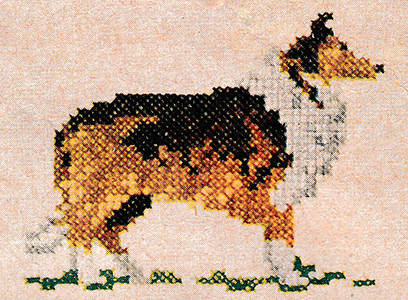
Pattern includes one each of six designs in 7 to the inch crosses for framed pictures, 8" x 10". Collie, 5⅜" x 6⅞"; Cocker Spaniel, 4⅛" x 6⅜"; Beagle, 4¼" x 5½"; Boston Terrier, 4⅛" x 5⅜"; German Shepherd, 5½" x 7⅛" and Boxer, 5⅜" x 6⅛".
MATERIALS REQUIRED: Smooth linen, medium weight linen-like cotton in white or unbleached muslin may be used for the background. For an 8" x 10" picture, use a piece of material about 12" x 14". See framing directions below.
EMBROIDERY COTTONS: Six-strand embroidery cotton should be used for the work. The set of six pictures requires one skein each of very dark brown, dark brown, medium dark brown, medium brown, gold, dark toast, toast, medium grey, dark green, medium green, light green, dark beige, light beige, medium blue grey, and 2 skeins each of navy, very deep gold, deep gold, dark grey and white and 4 skeins of black; a total of 28 skeins. One single dog requires one skein of each color with the following exception: the Cocker Spaniel requires 2 skeins of black and the Boxer, 2 skeins of very deep gold (instead of one skein).
CROSS-STITCH: Follow the chart in the pattern for placing the colors and use six strands of cotton in the needle for all work. It is very important when working cross-stitch to have the crosses of the entire piece crossed in the same direction. Whether one starts at the left and works right, or whether one starts right and works toward the left is optional. Keep the stitches as even as possible. Be sure to make all crosses touch. To do this, put the needle in the same hole as used for the adjoining stitch.
TO BLOCK DESIGN: Cover a large bread or drawing board with clean brown wrapping paper. Mark the size of linen rectangle, 12" x 14" on the brown paper. If the embroidered piece is badly soiled, it may be washed; if slightly soiled, dip in cleaning fluid. Place the wet piece (right side up) on the board, pull edges of linen to meet the guide lines drawn on the brown paper. Tack all edges of linen to the board, placing the thumb tacks close together. Allow the piece to remain on board until thoroughly dry.
BEFORE FRAMING: The embroidered piece should be stretched over a stiff piece of cardboard, cut to fit the frame. In stretching the material, be sure to keep the design perfectly straight. Pins driven through the material and into the edge of cardboard will be helpful in keeping the material straight. Paste edge of material down on the wrong side.
SUGGESTION FOR FRAMING: The frame illustrated is a raw wood frame 1¾" wide, size 8" x 10". The green mat cut to fit the frame has a 6" x 8" opening, thus leaving a 1" margin all around.
NOTE: If desired, the design may be worked in needlepoint.
DESIGN WORKED IN NEEDLEPOINT: The dogs illustrated were worked in cross-stitch, crosses 7 to the inch, on a linen background. If desired, the dogs may be worked in needlepoint on needlepoint canvas, following the charts. The charts are given in squares 10 to the inch which is a popular size for needlepoint canvas.
MATERIALS (CANVAS AND WOOL): Ten mesh to the inch canvas is suitable for one strand of tapestry wool or three strands of crewel wool. Use a piece of canvas 2 inches larger than the finished background size to allow for blocking. When buying wool, match colors to the illustrations. Use white or cream to fill in the background. The approximate amount of wool required may be figured by working one square inch of the background and checking the amount of wool used in relation to the yardage of the skein. One 12½-yard skein of tapestry wool embroiders about 5 square inches of canvas, 10 meshes to the inch, one strand in the needle.
CONTINENTAL NEEDLEPOINT STITCH: Start the design at the upper right hand corner, working each color from, right to left, then fill in the background. To begin work, hold an inch of wool in the back, working over this portion as you do your needlepoint. All other strands of wool may be started and finished by weaving in and out of the wrong side of finished work. Work back and forth, turning work upside down to work back, working from right to left as in details 1 and 2 at right.
BLOCKING: Use a smooth surface board, cover with brown paper and mark the size of canvas on this, squaring the corners. Place needlepoint right side down over the guide, true edges of canvas to the guide lines and fasten with thumb tacks placed ¾” apart along edges. Wet thoroughly with cold water and leave in position until thoroughly dry. Frame.
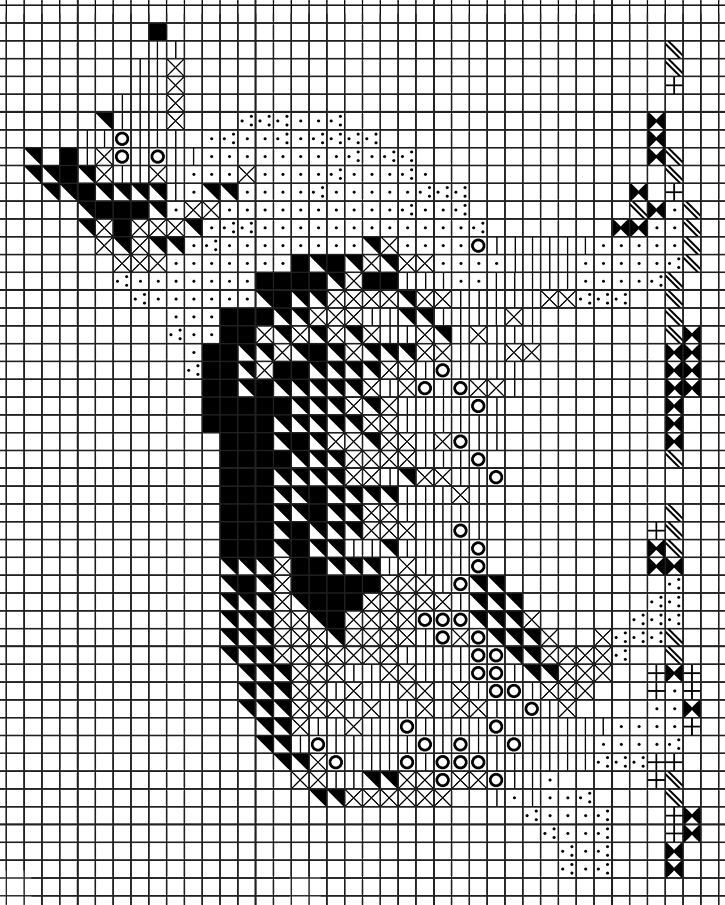
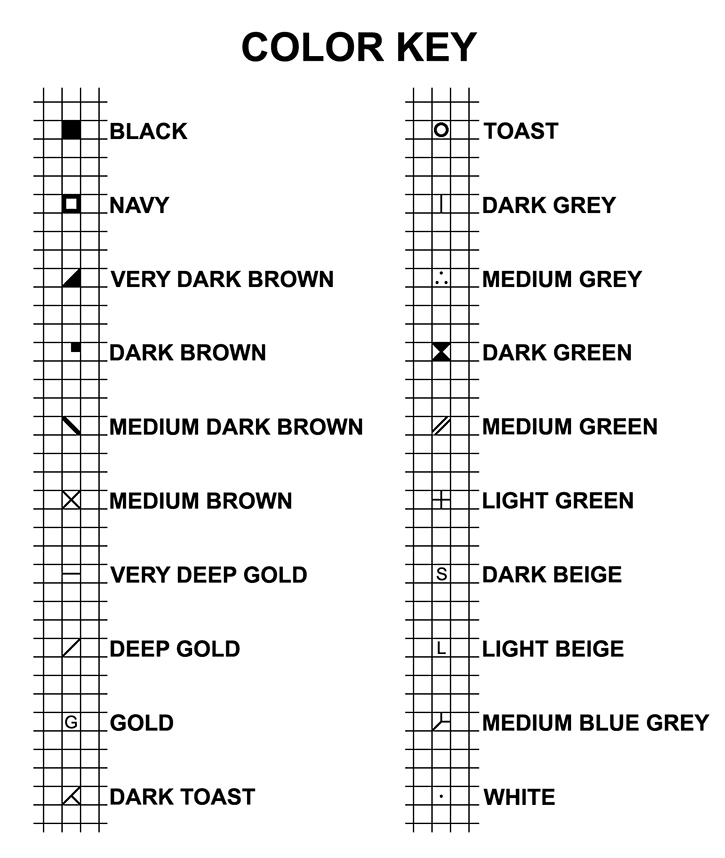
The Mallards | McCall's No. 1359

The Mallards
Pattern 1359
McCall's Pattern Company
Original Copyright 1947
Wild ducks in tangy marsh setting, worked in cross-stitch in brilliant autumn colors. A picture or wall hanging with the vividness of an oil pointing. Crosses 7 to the inch. Design 16 x 19¾" inches.
The popular, vivid mallards, so well known in the marshes and ponds from Nova Scotia to California, as well as in far-off Africa and India, are a colorful addition to any home. The brilliance and depth of color, and the realistic motion of the birds, combine to give the delightful feeling of a brisk October morning in the country.
MATERIALS REQUIRED: Six-strand cotton should be used for the work in the following amounts. One skein each of white, lt. grey, med. grey, bright green blue, bright med. blue, deep blue, bright yellow green, med. green, emerald green, lemon yellow, bright yellow, bright orange yellow, burnt orange, bright rose rust, deep rust, lt. gold, gold, rose, bright red, deep wine rose, 2 skeins each of black, med. brown and beige and 3 skeins of deep brown.
COLORS |
D.M.C. |
Bucilla |
White |
White |
2003 |
Light Grey |
318 |
2286 |
Medium Grey |
414 |
2291 |
Black |
Black |
2001 |
Bright Blue Green |
518 |
2582 |
Brigth Medium Blue |
826 |
2445 |
Deep Blue |
820 |
2452 |
Bright Yellow Green |
907 |
2060 |
Medium Green |
913 |
2242 |
Emerald Green |
911 |
2244 |
Lemon Yellow |
307 |
2574 |
Bright Yellow |
444 |
2515 |
Bright Orange Yellow |
741 |
2517 |
Burnt Orange |
922 |
N/A |
Bright Rose Rust |
919 |
2459 |
Deep Rust |
918 |
2462 |
Beige |
738 |
2464 |
Light Gold |
725 |
2535 |
Gold |
783 |
2536 |
Medium Brown |
435 |
2562 |
Deep Brown |
801 |
2568 |
Rose |
335 |
2430 |
Bright Red |
666 |
2042 |
Deep Wine Rose |
815 |
2016 |
The Mallards Chart Pattern

Pattern includes one transfer 16" x 19¾" for cross-stitch bird design, with crosses 7 to the inch. A chart for placing the colors is also included.
The popular, vivid mallards, so well known in the marshes and ponds from Nova Scotia to California, as well as in far-off Africa and India, are a colorful addition to any home. The brilliance and depth of color, and the realistic motion of the birds, combine to give the delightful feeling of a brisk October morning in the country.
MATERIALS REQUIRED: Six-strand cotton should be used for the work in the following amounts. One skein each of white, lt. grey, med. grey, bright green blue, bright med. blue, deep blue, bright yellow green, med. green, emerald green, lemon yellow, bright yellow, bright orange yellow, burnt orange, bright rose rust, deep rust, lt. gold, gold, rose, bright red, deep wine rose, 2 skeins each of black, med. brown and beige and 3 skeins of deep brown.
BACKGROUND MATERIAL: Unbleached muslin, smooth linen, medium-weight smooth linen-like cotton, are suggested materials. The background may be cream, natural or white. Use a piece of material 22 x 25¾ inches, or larger, if desired. See framing directions below. The design is also suitable for a wall hanging.
CROSS-STITCH: Follow the chart in pattern for placing the colors and use six strands of cotton in the needle for the work. It is very important when working cross-stitch to have the crosses of the entire piece cross in the same direction. A cross is made of an under stitch and an over stitch; all the under stitches must be worked in one direction and all the over stitches must cross them in the opposite direction. Whether one starts at the left and works right, as illustrated in detail 1, or whether one starts at the right and works left is optional. However, all the rows should be worked to the right or left throughout the entire piece. Keep the stitches as even as possible. Be sure to make all the crosses touch, as shown in detail 2. To do this, put the needle in the same hole as used for the adjoining stitch.
SUGGESTION FOR FRAMING: This lovely bird design when worked in cross-stitch is about 16 x 19¾ inches. You may allow a two-inch margin around the piece when framing; or from 2½ to 3 inches, as desired. The frame should blend with the shades in the picture or it may be dark brown or mahogany. When using a rectangular frame, the frame should be 2, 2½ or 3 inches wide.
Before framing, the embroidered piece should be stretched over a stiff piece of cardboard, cut the exact size of the frame. In stretching material, be sure to keep the design perfectly straight. Pins driven through the material and into the edge of the cardboard will be helpful in keeping the material straight and tight. The edges of the material may be pasted down on the wrong side of the cardboard, or the edges of material caught together with long zigzag stitches to hold the embroidery in place.
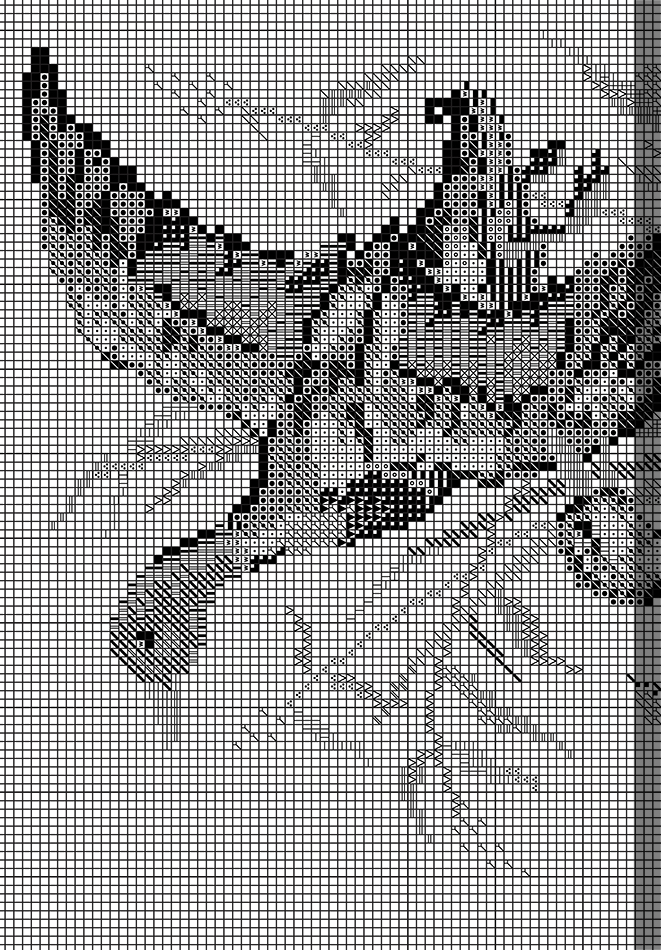
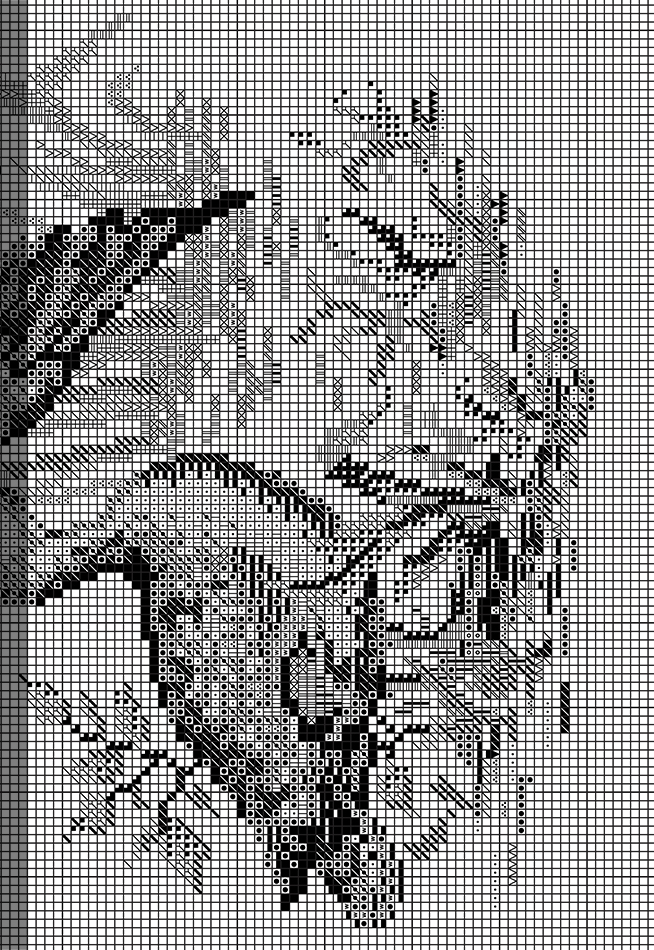
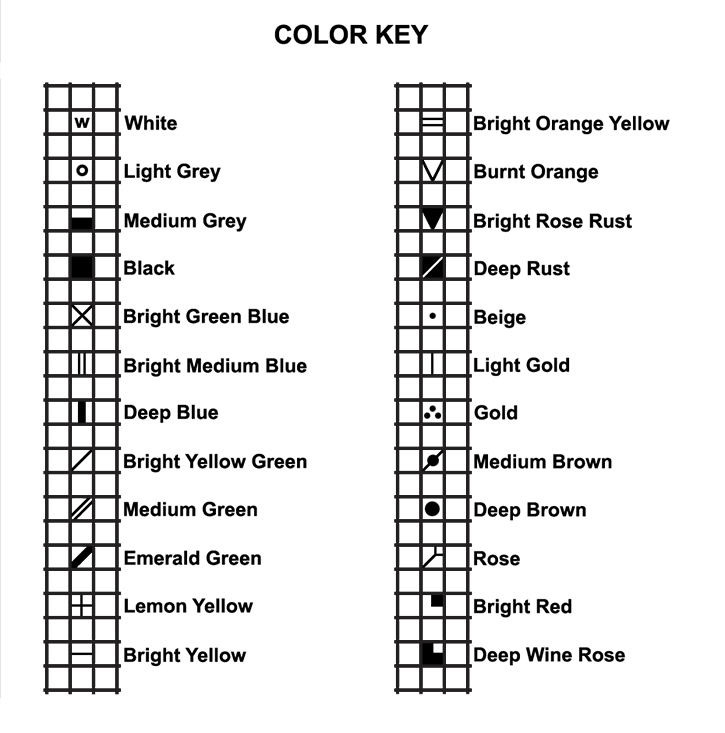
Fruit Motifs for Cross Stitch | McCall's No. 628

Fruit Motifs for Cross Stitch
Pattern 628
McCall's Pattern Company
Original Copyright 1938
Pattern includes 11 fruit motifs: peach 3¾ x 3¾ inches; pear 3⅜ x 4¼; orange 3¾ x 4¼; cherries 4⅜ x 4¼; grapes 4¾ x 4½; strawberries 2¾ x 3; pineapple 4 x 8⅛; lemon 3 x 3⅝; plums 3⅜ x 3¾; apple 3¾ x 4¼; and bananas 4⅜ x 4¾. A chart for placing the colors and diagrams showing how to arrange the motifs on lunch cloths, table cloth, runner and luncheon set are also included.
This colorful fruit design for cross stitch makes a charming decoration for lunch cloths, runners, lunch sets, table cloths, curtains and slip covers for chair backs. The 10 to the inch crosses are suitable for six strand cotton.
Suggested Materials—Linen, cotton with a linen finish, cotton broadcloth, percale, gingham, and unbleached muslin are suitable materials. The diagrams in the pattern show the pieces made of 36-inch material. The large cloth can be made of 36, 54 or 72-inch material.
How to Use Design—The diagrams on the leaflet give the finished sizes of the linens. When cutting material, allow ⅜ inch for seams and ⅜ inch for narrow hems. We advise narrow hems for all the pieces shown on the leaflet except the 36-inch lunch cloth. This cloth is finished with a contrasting binding. One diagram shows a table cloth, finished size 54 x 72 inches. This cloth can be made of 36, 54 or 72-inch material. If using 36-inch material, use the full width through the center and narrow strips at each side as shown in the diagram. The diagram also shows the arrangement of the motifs. Another diagram shows a 54-inch cloth made of two contrasting colors, using white for the center and colored material for the border. This diagram also shows an interesting arrangement of the motifs. The 36-inch cloth in the diagram has a bound edge. A runner size 16 x 36 inches is also shown. This is made of two contrasting colors, using one color for the center and the other for the border at sides. Diagrams are given for a luncheon set made of two contrasting colors. The centerpiece is 11 x 22 inches and the place mat is 11 x 17 inches. On the place mats use the smaller motifs, such as the strawberries, plums, peaches, lemons and oranges.
The illustration on the front of envelope shows the motifs used on a large cloth 54 x 72 inches. The illustration also shows the motifs used on a slip cover for chair back and on curtains.
Before Working—Cut the material to the desired size, being sure to allow ⅜ inch for seams, and ⅜ inch for narrow hems. The measurements given in the diagrams on the leaflet are finished sizes. Use narrow flat hems on the 54 x 72 inch cloths. On the smaller cloths, runners and luncheon sets, use plain rolled hems, or work over the rolled hems with cross stitch.
To Embroider—Use six strand cotton using three strands in the needle for all work. The entire design is done in cross stitch. The most satisfactory results are obtained when the crosses touch as shown in the detail. Follow the chart on the leaflet for placing the colors.
Bananas Chart Pattern

Pattern includes 11 fruit motifs: peach 3¾ x 3¾ inches; pear 3⅜ x 4¼; orange 3¾ x 4¼; cherries 4⅜ x 4¼; grapes 4¾ x 4½; strawberries 2¾ x 3; pineapple 4 x 8⅛; lemon 3 x 3⅝; plums 3⅜ x 3¾; apple 3¾ x 4¼; and bananas 4⅜ x 4¾. A chart for placing the colors and diagrams showing how to arrange the motifs on lunch cloths, table cloth, runner and luncheon set are also included.
This colorful fruit design for cross stitch makes a charming decoration for lunch cloths, runners, lunch sets, table cloths, curtains and slip covers for chair backs. The 10 to the inch crosses are suitable for six strand cotton.
Suggested Materials—Linen, cotton with a linen finish, cotton broadcloth, percale, gingham, and unbleached muslin are suitable materials. The diagrams in the pattern show the pieces made of 36-inch material. The large cloth can be made of 36, 54 or 72-inch material.

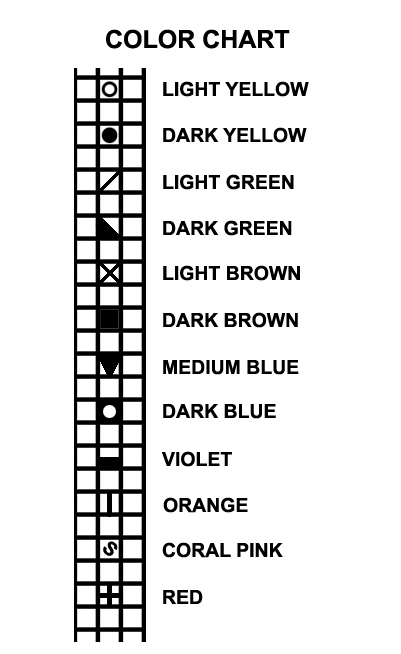
Peach Chart Pattern
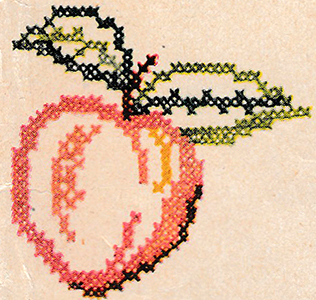
Pattern includes 11 fruit motifs: peach 3¾ x 3¾ inches; pear 3⅜ x 4¼; orange 3¾ x 4¼; cherries 4⅜ x 4¼; grapes 4¾ x 4½; strawberries 2¾ x 3; pineapple 4 x 8⅛; lemon 3 x 3⅝; plums 3⅜ x 3¾; apple 3¾ x 4¼; and bananas 4⅜ x 4¾. A chart for placing the colors and diagrams showing how to arrange the motifs on lunch cloths, table cloth, runner and luncheon set are also included.
This colorful fruit design for cross stitch makes a charming decoration for lunch cloths, runners, lunch sets, table cloths, curtains and slip covers for chair backs. The 10 to the inch crosses are suitable for six strand cotton.
Suggested Materials—Linen, cotton with a linen finish, cotton broadcloth, percale, gingham, and unbleached muslin are suitable materials. The diagrams in the pattern show the pieces made of 36-inch material. The large cloth can be made of 36, 54 or 72-inch material.
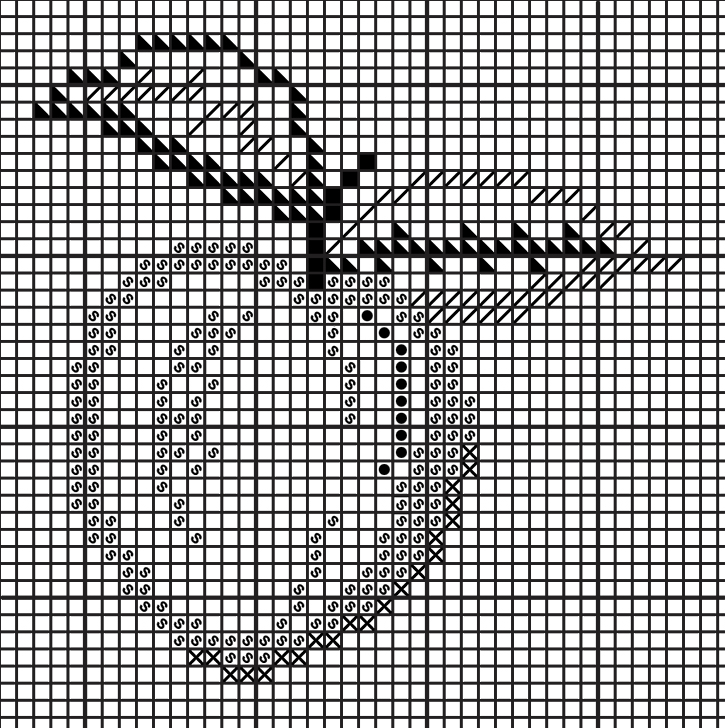

Cherries Chart Pattern

Pattern includes 11 fruit motifs: peach 3¾ x 3¾ inches; pear 3⅜ x 4¼; orange 3¾ x 4¼; cherries 4⅜ x 4¼; grapes 4¾ x 4½; strawberries 2¾ x 3; pineapple 4 x 8⅛; lemon 3 x 3⅝; plums 3⅜ x 3¾; apple 3¾ x 4¼; and bananas 4⅜ x 4¾. A chart for placing the colors and diagrams showing how to arrange the motifs on lunch cloths, table cloth, runner and luncheon set are also included.
This colorful fruit design for cross stitch makes a charming decoration for lunch cloths, runners, lunch sets, table cloths, curtains and slip covers for chair backs. The 10 to the inch crosses are suitable for six strand cotton.
Suggested Materials—Linen, cotton with a linen finish, cotton broadcloth, percale, gingham, and unbleached muslin are suitable materials. The diagrams in the pattern show the pieces made of 36-inch material. The large cloth can be made of 36, 54 or 72-inch material.
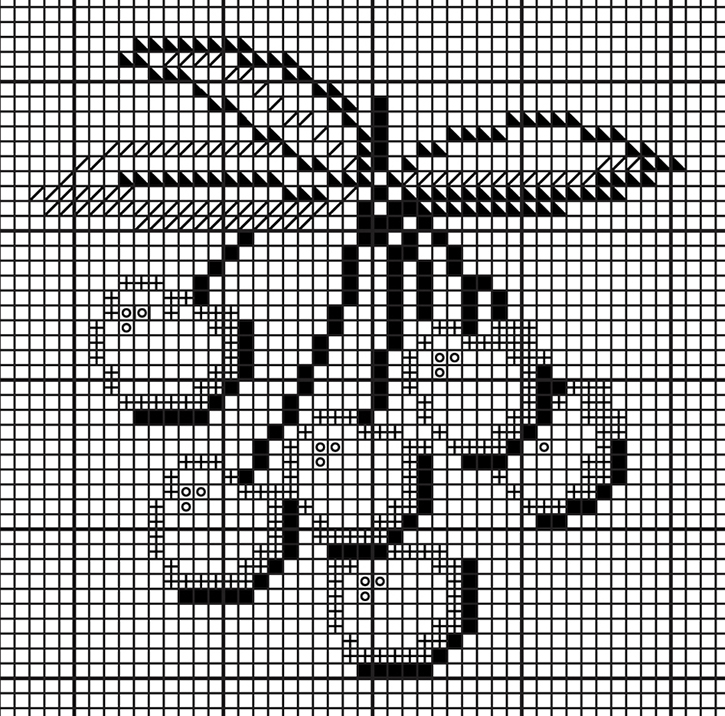
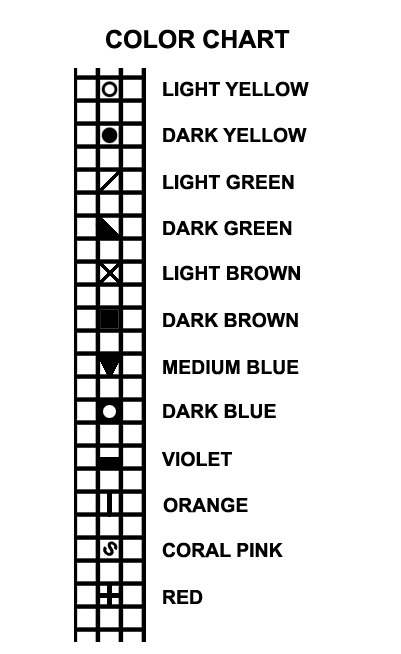
Strawberries Chart Pattern
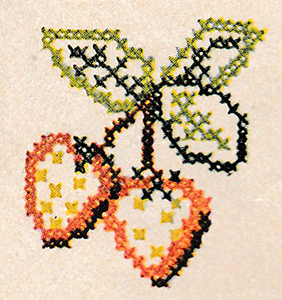
Pattern includes 11 fruit motifs: peach 3¾ x 3¾ inches; pear 3⅜ x 4¼; orange 3¾ x 4¼; cherries 4⅜ x 4¼; grapes 4¾ x 4½; strawberries 2¾ x 3; pineapple 4 x 8⅛; lemon 3 x 3⅝; plums 3⅜ x 3¾; apple 3¾ x 4¼; and bananas 4⅜ x 4¾. A chart for placing the colors and diagrams showing how to arrange the motifs on lunch cloths, table cloth, runner and luncheon set are also included.
This colorful fruit design for cross stitch makes a charming decoration for lunch cloths, runners, lunch sets, table cloths, curtains and slip covers for chair backs. The 10 to the inch crosses are suitable for six strand cotton.
Suggested Materials—Linen, cotton with a linen finish, cotton broadcloth, percale, gingham, and unbleached muslin are suitable materials. The diagrams in the pattern show the pieces made of 36-inch material. The large cloth can be made of 36, 54 or 72-inch material.

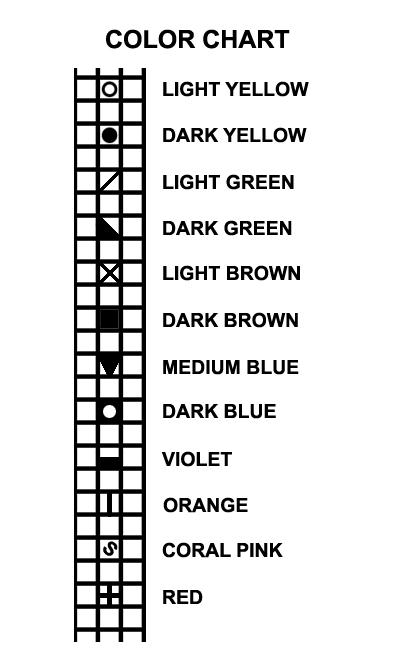
Grapes Chart Pattern
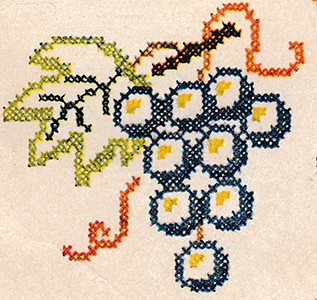
Pattern includes 11 fruit motifs: peach 3¾ x 3¾ inches; pear 3⅜ x 4¼; orange 3¾ x 4¼; cherries 4⅜ x 4¼; grapes 4¾ x 4½; strawberries 2¾ x 3; pineapple 4 x 8⅛; lemon 3 x 3⅝; plums 3⅜ x 3¾; apple 3¾ x 4¼; and bananas 4⅜ x 4¾. A chart for placing the colors and diagrams showing how to arrange the motifs on lunch cloths, table cloth, runner and luncheon set are also included.
This colorful fruit design for cross stitch makes a charming decoration for lunch cloths, runners, lunch sets, table cloths, curtains and slip covers for chair backs. The 10 to the inch crosses are suitable for six strand cotton.
Suggested Materials—Linen, cotton with a linen finish, cotton broadcloth, percale, gingham, and unbleached muslin are suitable materials. The diagrams in the pattern show the pieces made of 36-inch material. The large cloth can be made of 36, 54 or 72-inch material.
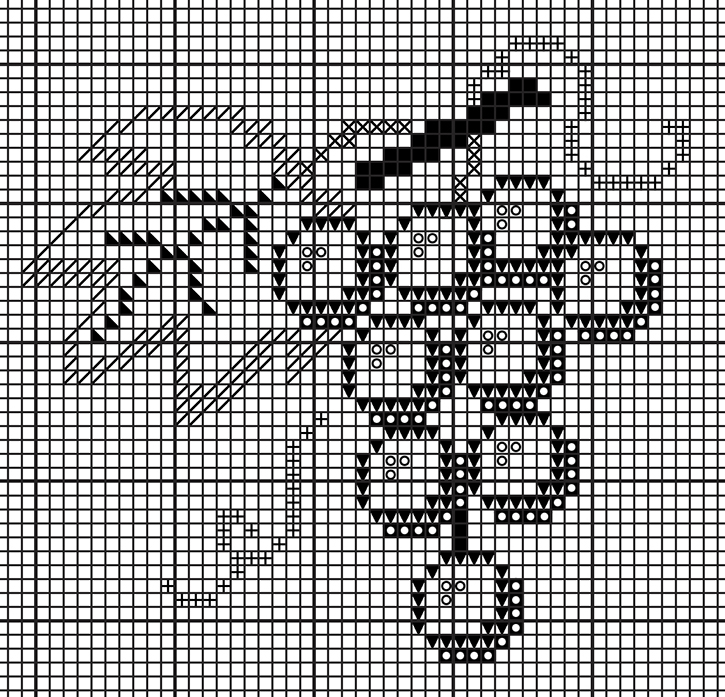
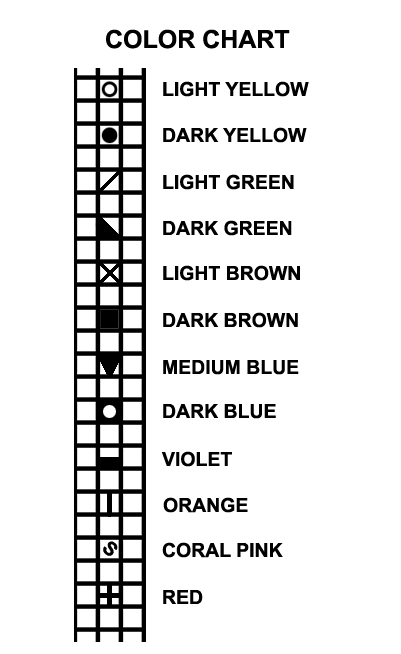
Lilacs and Tulips Chart Pattern
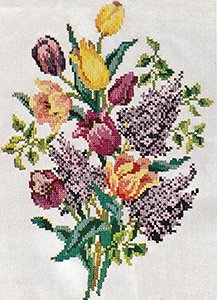
Pattern includes one pattern 13¾" x 18¾" for cross-stitch floral spray. A chart for placing the colors is also included in the pattern.
Done in the style of a flower print, this cross-stitch "print" carries out a lovely idea in decor. The rich color scheme of this beautiful spray of tulips and lilacs will blend with almost any interior. If you choose the colors in six-strand embroidery colors to match those on the envelope, the picture will have the richness and beauty of a painting.
MATERIALS REQUIRED—Six-strand embroidery cotton should be used for the work in the following colors and amounts. One skein each of light yellow, yellow, orange yellow, rust, peach, medium coral, deep coral, pale coral, bright rose, soft rose, rose, medium wine, dark wine, pink, light yellow green, gold brown and black and two skeins each of lavender, violet, deep violet, medium green, dark green, light blue green and blue green.
BACKGROUND MATERIAL—Unbleached muslin, smooth linen, medium weight linen-like cotton are suggested materials for the background. The background may be white, grey or a pastel color. Use a piece of material about 18" x 23" or larger, if desired. See framing directions below. The design is also suitable for a wall hanging.
CROSS-STITCH—Follow the chart in the pattern for placing the colors and use six strands of cotton in the needle for the work. It is very important when working cross-stitch to have the crosses of the entire piece crossed in the same direction. A cross is made of an under stitch and an over stitch; all the under stitches must be worked in one direction and all the over stitches must cross them in the opposite direction. Whether one starts at the left and works right, or whether one starts at the right and works toward the left is optional. However, all the rows should be worked to the right or left throughout the entire piece. Keep the stitches as even as possible. Be sure to make all crosses touch. To do this, put the needle in the same hole as used for the adjoining stitch.
SUGGESTIONS FOR FRAMING—This lovely spray of flowers when worked in cross-stitch is about 13¾" x 18¾". You may allow a narrow one-inch background margin around the piece when framing, or from two to three inches, as desired. The frame may be natural, antique white, ivory, maple, gold, mahogany, etc. When using a rectangular frame as shown on the front of envelope, the frame should be about one inch wide or more.
Before framing, the embroidered piece should be stretched over a stiff piece of cardboard, cut the exact size of the frame. In stretching material, be sure to keep the design perfectly straight. Pins driven through the material and into the edge of the cardboard will be helpful in keeping the material straight and tight. The edges of material may be pasted down on the wrong side of the cardboard, or caught together with zig-zag stitches to hold the embroidery in place.
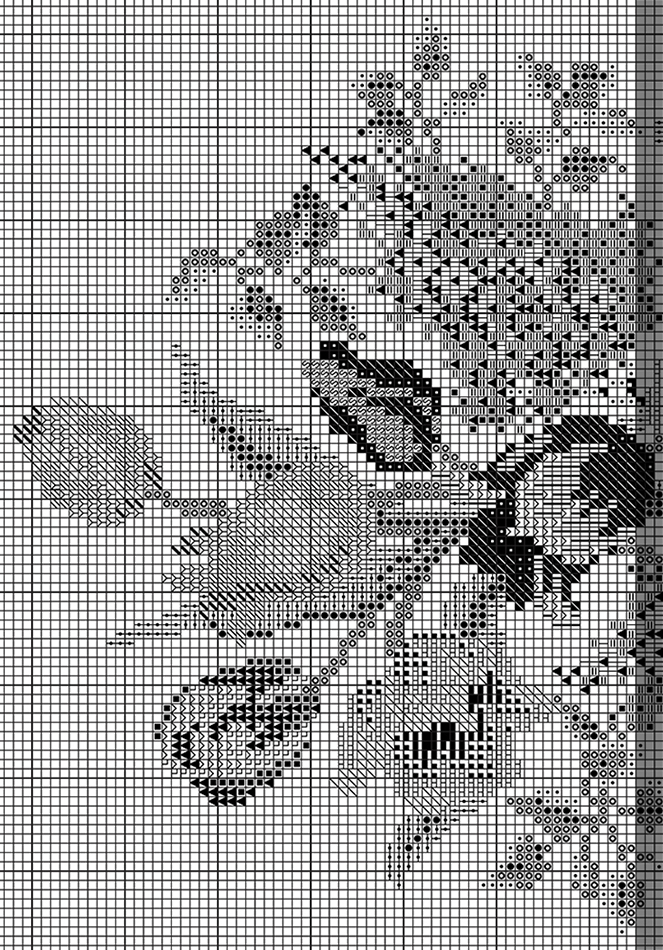

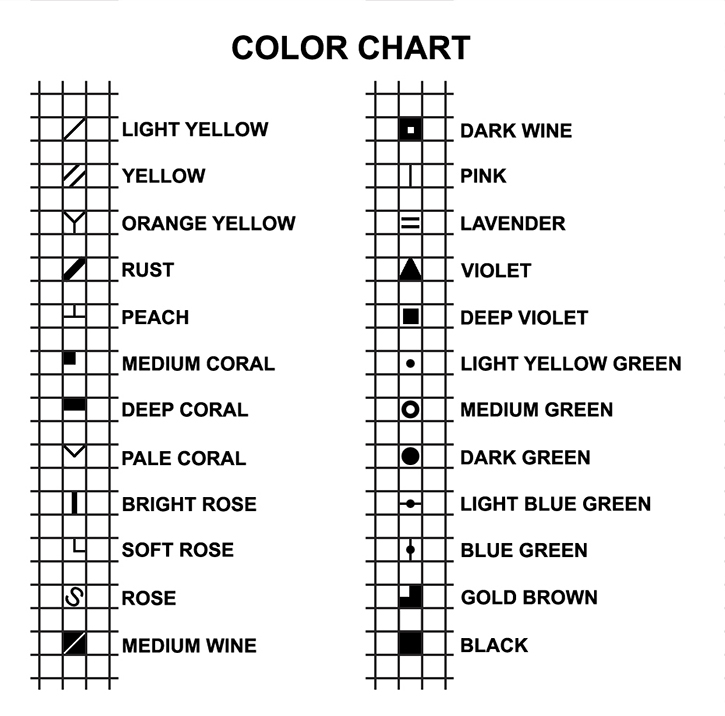
| Pattern Categories Browse the categories to help you find the patterns you're looking for. |
||

